ST PETERSBURG (pop. 4.8 million)
History. Peter built the Peter and Paul Fortress in 1703 founding the city. The capital was moved from Moscow. Artisans and architects came from all over Europe, so that by 1725, when Peter died, the city had 40,000 citizens and 90% of Russia’s trade came through St Petersburg. Between 1741 and 1825, during the reigns of Elizabeth, Catherine the Great and Alexander I, it became a cosmopolitan city with an imperial court of famed splendour. They commissioned a great series of palaces, government buildings and churches, turning it into one of Europe’s grandest capitals.
The emancipation of serfs in 1861 and industrialization that peaked in the 1890s brought a flood of poor workers into the city, leading to squalor, disease and festering discontent.
Renamed Leningrad after Lenin died in 1924, the city became the hub of Stalin’s 1930s industrialization program. By 1939, the population was 3.1 million accounting for 11% of Soviet industrial output.
When Germany attacked the USSR in June 1941, its armies took only 2½ months to reach Leningrad. As the birthplace of Bolshevism, Hitler swore to wipe the city from the face of the earth, besieging it until January 1944. About a million people died (by comparison, the USA and Britain suffered about 700,000 deaths between them in all of WWII). Food was practically nonexistent, people ate their pets, paste behind wallpaper, and leather and eventually, most turned to cannibalism. But the city survived. It took until 1960 for the population to exceed WWII’s levels.
In 1991, after the fall of the Soviet Union, the city’s citizens voted to bring back the name of St Petersburg. In the anarchic early 90s, it often seemed like the local ‘Mafia’ was more in charge than the elected officials, who proved to be equally corrupt.
Originally an uninhabited swamp spread over many islands in the delta of the Neva River where it empties into the Gulf of Finland, it has become one of the world’s great cities. Grand buildings line Nevsky Prospect and the many canals and riverbanks. Called the ‘Venice of Russia’, there are 342 bridges in the city. Its main sites are fairly centred in the historic heart. It is easy to walk everywhere and the metro, like those elsewhere, easy to navigate.
St Petersburg has the appearance of a prosperous city. I saw no homeless people, no garbage, and the only panhandler was an occasional elderly woman. All cars are foreign with a preponderance of BMWs, Audis, Mercedes, Japanese and Korean vehicles. I saw little evidence of alcohol abuse or poverty.
At least six days are necessary to see most of the sites including the several palace complexes outside town. On my third evening here, I saw Tchaikovsky’s Swan Lake performed at the Mikhailovsky Theatre. The $80 cost was a third of the already sold-out Swan Lake at the Bolshoi in Moscow.
Hermitage. One of the world’s great museums (comparable to the Louvre and MOMA), it is an equally confusing place to visit. About 5% of the enormous collection of over 3 million items is on view in 5 buildings that from the outside look like one. The exterior is a green, white and gold profusion of columns, windows and recesses; the roof is topped with rows of statues. The Neva River is on one side and the huge Palace Square is on the other. The main building is the Winter Palace built in 1754. It alone has 1057 rooms, three stories and 117 staircases. It doesn’t help to plan as you never know where you are.
The Hermitage’s collection began with Catherine the Great, one of the greatest art collectors of all time. Nicholas I greatly enriched the collection and opened it to the public in 1852. In the post-revolutionary period, the collection increased three-fold as many valuable private collections were seized by the state. In 1948 it incorporated the renowned collections of post-Impressionistic and Impressionistic paintings of two Moscow industrialists. The result is a comprehensive history of Western European art.
It is not cheap – general admission is 400R, plus 300R each for the Treasury Room and Gold Room (about $26). It would be best to buy tickets online ($25.95) which gives access to the main museum plus four other separate buildings not included above, allows visits over 2 days and bypass the enormous queues for tickets. I walked out exhausted after 7 hours.
The interiors are magnificent with grand staircases, the Romanov’s private apartments, the Peacock Clock and of course all the great artists of Europe. I paid the extra fees to see the Gold Room (the most interesting were the Synthian gold from the 4th-7th centuries BC) and the Treasure Room with the over-the-top appetites of the Russian leaders in full evidence.
Church of the Savior on Spilled Blood
This has become my favourite church easily comparable to the Burgos Cathedral in Spain It was built between 1883-1907 on the spot where Alexander II was assassinated. It took 24 years to build and 27 years to restore, reopening in 1997. The outside has multiple colourful domes and the crests of all Russian states in mosaics.

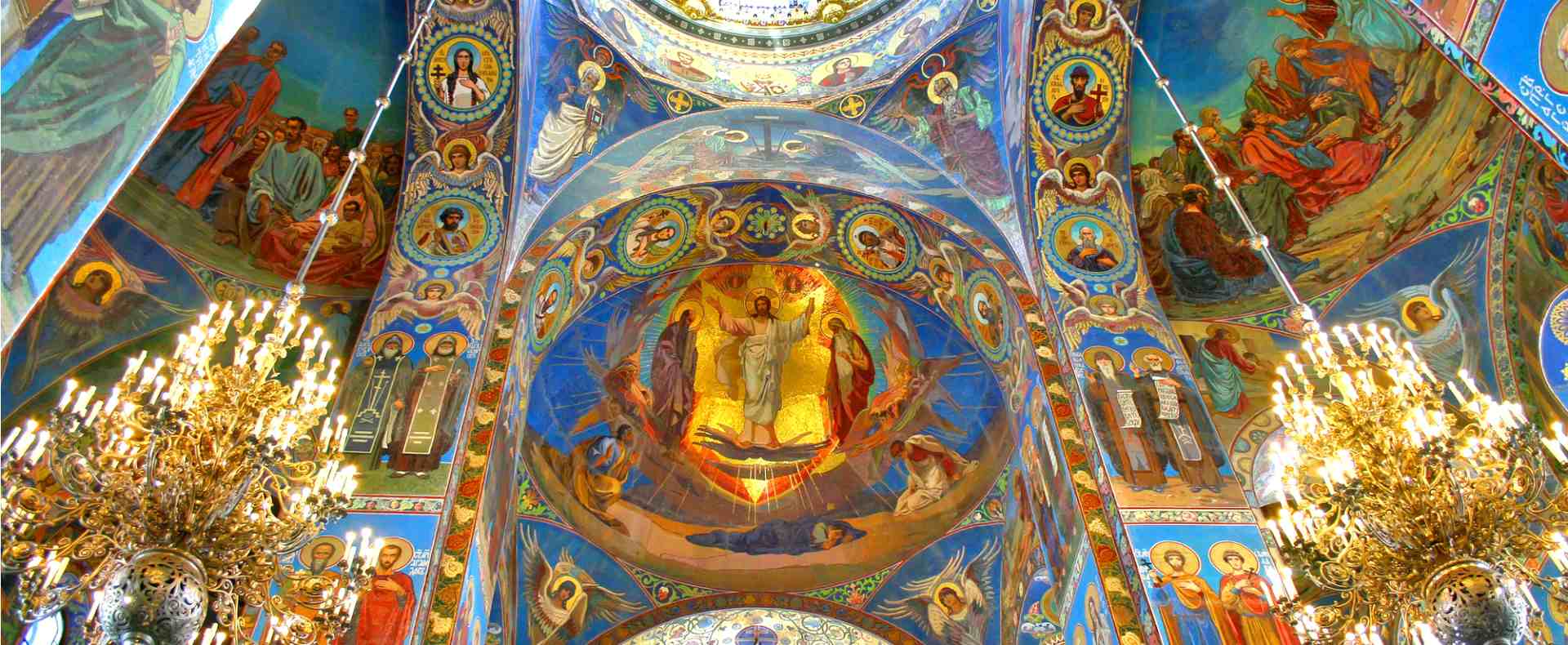
It took 30 artists to restore the interior’s incredible 7000 sq. m of mosaics covering every inch of wall, arch and ceiling. The marble floor is dazzling as is the marble surrounding the iconostasis.
St Isaac’s Cathedral. The golden dome of this mammoth church (101.5m tall, 111 by 97m inside, the dome has a diameter of 25.8m) dominates the St Petersburg skyline. The lavish 4,100 sq. m interior is a monument to marble and malachite, mosaic iconoclasts and art. Special ships and a railway had to be built to carry from Finland the 48 massive granite pillars on the outside – each 17m tall pillar weighs 119 tons.
Peter and Paul Fortress.
Across the Neva River from the Hermitage is this first structure in St Petersburg.|
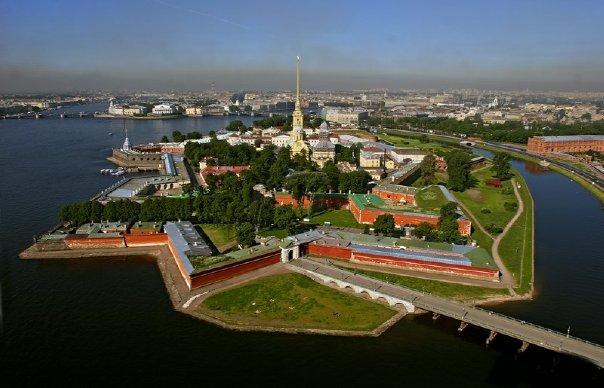
Inside is the St Peter and Paul Cathedral with its 122m-tall needle-thin, gilded spire. Its interior is the resting place for all of Russia’s pre-revolutionary rulers including the remains of Nicholas II and his murdered family which were discovered and placed here in 1998)
St.Petersburg-Glavny is a railway station terminal, the terminus for the Saint Petersburg – Moscow Railway and other lines from Central and South Russia, Crimea, Siberia and Eastern Ukraine. The oldest preserved station in the city, it was erected in 1844-51. Although large “Venetian” windows, two floors of Corinthian columns and a two-storey clocktower are Italian Renaissance architecture, the building incorporates other features from various periods and countries. A twin train station, currently known as the Leningradsky, was built to Thon’s design at the other end of the railway, in Moscow. While Thon’s facade remains intact, the station was renovated in 1869-79, 1912, 1950-52 and 1967. A bronze bust of Peter the Great in the main vestibule replaced a bust of Lenin in 1993. It is served by the Mayakovskaya and Vosstaniya Square stations of the Metro.
Avtovo Metro Station. The grand columns and marble interior make commuters wonder if they have arrived at a subway stop or a palace. The ceiling is supported by 46 columns, 30 are made of marble and 16 are decorated with glass. The station’s theme is the defence of Leningrad during the Siege of the Second World War.
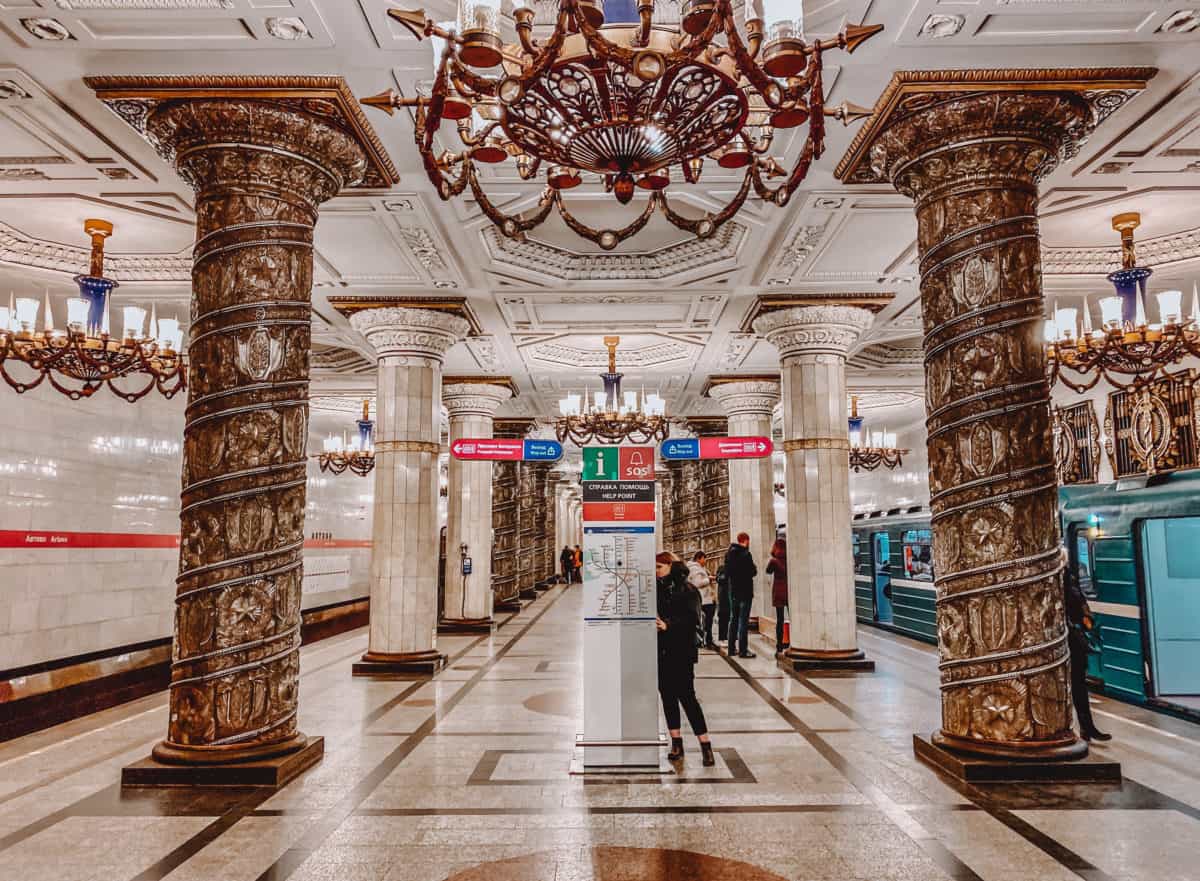
Kirovsky Zavod Metro Station. The name comes from the Kirovsky factory located in the vicinity, and the general theme is the development of socialist industry. The haut-reliefs on the walls of the station depict the various industries of the former Soviet Union: electricity, oil, coal mining and metal production. The station is decorated with grey-coloured marble.
Saspan is a high-speed train between St. Petersburg at the centrally located Moskovsky Station 4 hours later arriving at Leningradskaya Station in the heart of Moscow. Opened in December 2009, the Sapsan (Russian for Peregrine Falcon).has a maximum speed of 250km/h. The convenience rivals travelling by air. The short flight time of one hour between St. Petersburg and any of the seven airports that service Moscow lures travellers at first. It is common to spend three or more hours in traffic getting to and from the city centres to the airports.
Beloselskiy-Belozerskiy Palace is a 1747 Neo-Baroque palace. Elena Pavlovna produced its lavish appearance. In addition to the Belosselsky Belozersky wealth stemming from their south Urals metal works, Elena Pavlovna also inherited a fortune from her family, the Bibikovs. She had the old building knocked down and had a new palace built that became the venue of the most lavish balls and concerts in St. Petersburg. With major renovations in 1847-48 (a dazzling Rococo), it is now a municipal cultural centre with chamber concerts for small audiences.
Menshikov Palace on Vasilyevsky Island 1710. was the first stone building in the city. Since 1981, it has served as a branch of the Hermitage Museum with a collection of Russian art from the late 17th to early 18th century.
Moika Palace or Yusupov Palace was once the primary residence of the Yusupov family built in 1776. The building was the site of Grigori Rasputin’s murder in the early morning of December 17, 1916. The Yusopov family acquired more than 40,000 works of art, including works by Rembrandt, jewelry, and sculptures decorated the palace. Following the Russian Revolution, the palace was nationalized and its works of art were largely relocated to the Hermitage and other museums. Today, it serves as a “Palace of Culture for Educators”. The part of the building associated with Rasputin’s murder is a museum.
Stroganov Palace. The Soviets declared the palace a national museum chronicling the lifestyle of the Russian nobility. In 1929 the museum was shut down, and much of its contents (including some priceless paintings and objets d’art) were taken to the Hermitage Museum. After other uses, in 1988 the palace was given to the Russian Museum, underwent a thorough restoration and is one of the few Baroque structures on Nevsky Prospect to preserve its original appearance.
Marble Palace is one of the first Neoclassical palaces. The palace takes its name from its opulent polychrome marble. A rough-grained Finnish granite on the ground floor is a subtle contrast to the polished pink Karelian marble of the pilasters and the white Urals marble of capitals and festoons. Panels of veined bluish-gray Urals marble separate the floors, while Tallinn dolomite was employed for ornamental urns. In all, 32 disparate shades of marble were used to decorate the palace. It has a permanent collection of the Russian State Museum, notably “Foreign artists in Russia (18th and 19th centuries)” and the Peter Ludwig Museum at the Russia Museum featuring canvases by Andy Warhol and other Pop Art idols.
Yelagin Palace is a Palladian villa on Yelagin Island which served as a royal summer palace during the reign of Alexander I. Constructed in 1822, it currently houses a collection of objets d’art from the 18th and 19th centuries, notably precious glassware.
AROUND ST PETERSBURG
Peterhof. This was the country residence of Peter the Great constructed from 1716-1723, 28 km west of St Petersburg on the Gulf of Finland. The Palace was enlarged twice by Elizabeth and Catherine to its present grand size. Only a few walls remained after it was heavily bombed by the Soviets in January 1942 to prevent Hitler from using it for his invasion celebration. The restoration is remarkable. It is best known for the surrounding park and incredible display of fountains, all fed by gravity. I arrived by bus and was let off outside the upper park. You walk past several wonderful fountains and enter the lower park to the side of the palace.
Peterhof is expensive to see everything (entrance to the lower park 500R, Grand Palace 500R and 250R each for the 13 palaces and other attractions spread throughout the lower park – a total of 4250R or about $112). The main group of 140 fountains just below the palace called the Grand Cascade, turned on at 11 am. Many of the imposing fountains are gold animals and men. The water then flows down a canal to the Gulf of Finland. The grounds are impressive and have fountains all over the place.
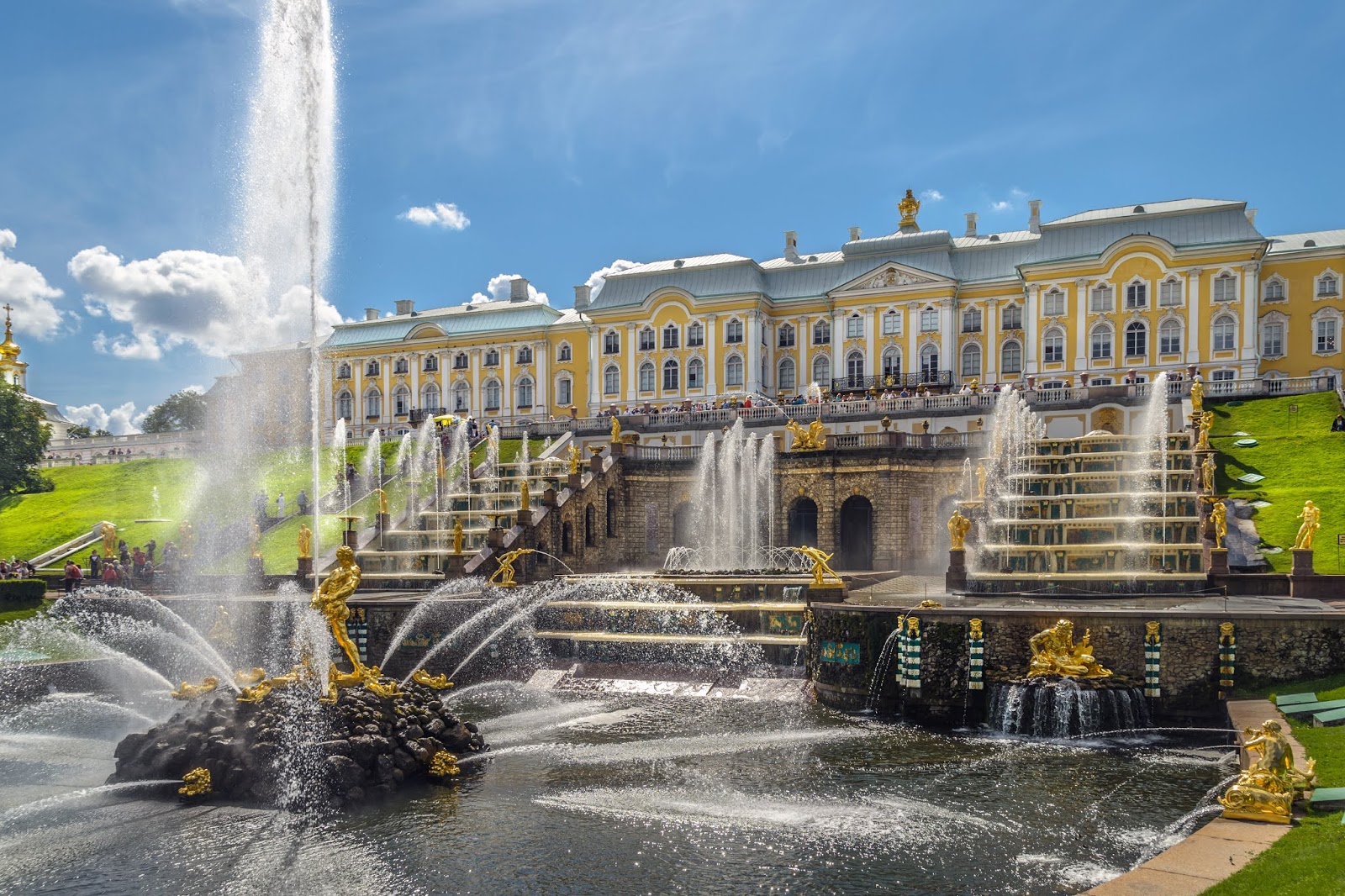

Pavlovsk
South of St Petersburg and 4km past Pushkin, is the Grand Palace constructed by Catherine the Great in 1781-6 for her son Paul. The original palace was burnt down 2 weeks after liberation in 1945 when a Soviet soldier’s cigarette detonated a German mine. The restoration is also remarkable. The huge Pavlovsk Great Park (at 534 hectares the largest park in Europe) is Unesco World Heritage listed and filled with rivers, lakes, avenues, statues and temples that could take a whole day to explore.
Pushkin (Tsarskoe Selo)
25 km south of St Petersburg, the vast, baroque Catherine Palace (1744-1796) and remodelled by Catherine the Great. After being almost destroyed by the Nazis in WWII, it too has been beautifully restored.
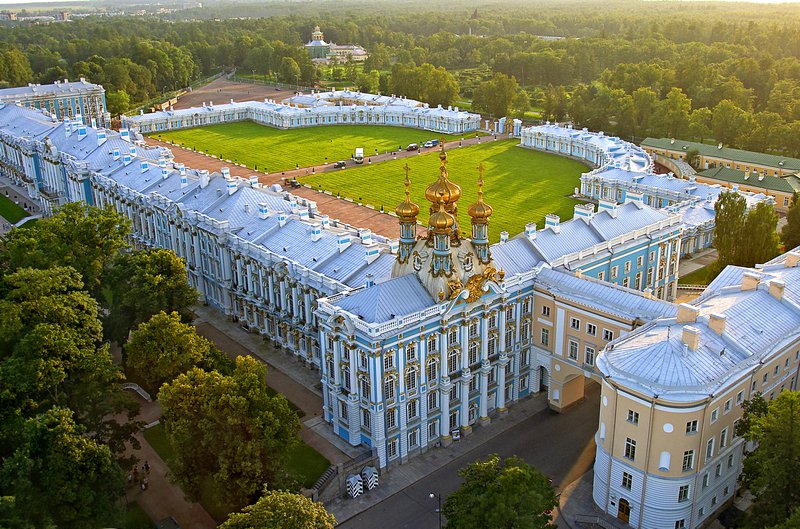

With a gaudy blue and white exterior, it has 20 spectacular rooms, the most famous of which is the Amber Room. The original was created from exquisitely engraved amber panels given to Peter the Great by the King of Prussia in 1716. The panels were combined with woodcarvings, mirrors, agate and jasper mosaics, but were plundered by the Nazis and later exhibited at Konigsberg’s Castle which was in ruins by 1945. Presumably, the Amber Room was destroyed along with it. Or was it? In 2004, Putin and German Chancellor Gerhardt Schroder presided over the new $18 million restoration of the Amber Room, restored largely with German funds. Some believe the original remains hidden away but the mystery continues. It is an amazing room.
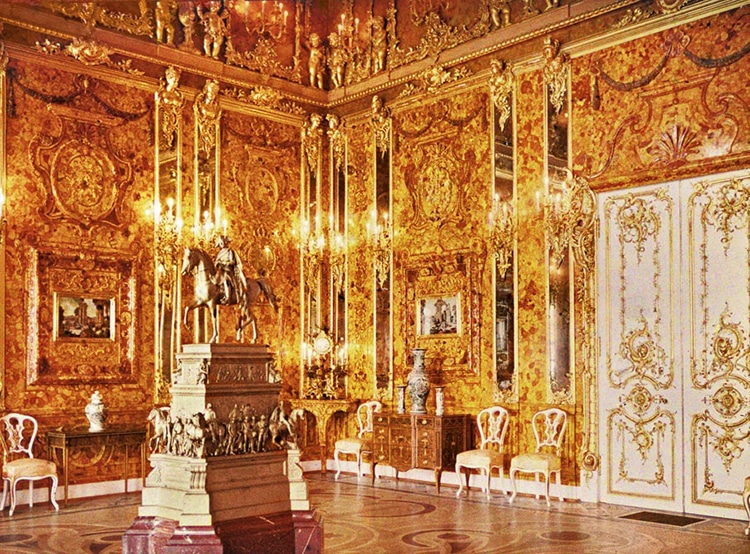
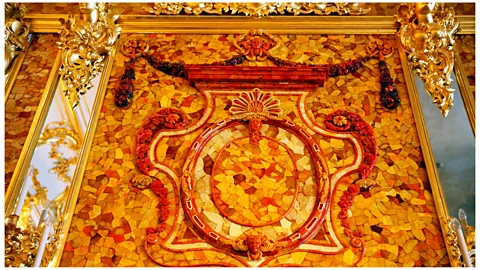
The wood parquet floors throughout the palace are also outstanding.
On one side of the palace is the wonderful Catherine Park. A large lake is surrounded by an interesting collection of buildings (several baths, concert halls and palaces) that can easily take two hours to explore.
Alexander Park and Palace was built for Alexander I but Nicholas II, the last Russian tsar, was its main tenant and used it for much of his reign. Only 3 rooms are open and it is not much visited.
One could easily spend all day here to see everything.
Other sites around St Petersburg include Gatchina (another grand palace built by Catherine the Great for her favourite, Greagory Orlov) and Kronshtadt (a fortress in the Gulf of Finland with a cathedral as its highlight).
MOSCOW’S METRO STATIONS – Underground Art
Initially, this appears to be the most difficult metro in the world to navigate. The directions to connecting stations are usually on the floor. The real challenge is the directions at each station (which side to be on for your destination) are all in Cyrillic. On the wall opposite where you stand to board, the stations for your particular line are on the top row in the colour of the line and under each are listed the stations of the line that that station connects to. It takes a while to understand. The trains are reliable and you rarely wait longer than 3 minutes. The escalators in Moscow’s Metro stations must be the longest in the world. I timed how long the ride was – 123 seconds. They are deep so they could function as bomb shelters in war.Moscow’s Metro stations are spectacular creations of art. All 150+ of them are nice with a profusion of marble in the stations and passages connecting stations. It is easy to see the 15 or so best ones in about 3 hours. This will be your cheapest 3 hours in Moscow – you can see them all for one $1 (40R) fare.
Most of the good stations are on two lines – the ring Kolsevaya or brown line (arguably the most opulent in a system known for its palatial stations) and the Arbatsko-Pokrovskaya or dark blue line – only three on my list were off these lines. Start your trip at 9 pm when the system is not busy. I started my evening at Tsetvoy Bulvar on the grey line.
From Tsetvoy Bulvar go NW to Novosloboskaya (Koltsevaya or brown line).
1. Novoslobodskaya. It is best known for its 32 stained glass panels. Each panel, surrounded by an elaborate brass border, is set into one of the station’s pylons and illuminated from within. The pylons and the pointed arches between them are faced with pinkish Ural marble and edged with brass moulding. At the end of the platform is a mosaic by Pavel Korin entitled “Peace Throughout the World.” The vestibule is an imposing structure with a grand portico on the northeast corner of Novoslobodskaya Ulitsa and Seleznevskaya Ulitsa.

Continue on the brown line to:
2. Belorusskaya. It is named for the nearby Belarus rail terminal. It opened in 1952, serving briefly as the terminus before the circle was completed in 1954. The station has low, white marble pylons, an elaborately patterned plaster ceiling, light fixtures supported by ornate scroll-shaped brackets, and a variety of decorations based on Belarusian themes. Overhead, twelve octagonal mosaics depict Belarusian daily life, and underfoot the platform is intricately tiled to resemble a Belarusian quilt. A sculptural group called “Soviet Belorussia” used to stand at the end of the platform before it was removed in 1998 to make room for a second entrance. Another sculptural group, “Belarusian Partisans,” is located in the passage between this station and Belorusskaya-Radialnaya.

Change to the dark green line for a short detour to the gem of the system:
3. Mayaskovskaya. This is a monument to pre-WWII Stalinist Architecture. There are stainless steel and pink rhodonite columns with grey marble walls. The floor is marble in geometric patterns. The highlight is 34 inset ceiling mosaics showing an idealized Soviet future. Most have airplanes, but some show sports and flowers. This station was the Grand Prize winner at the 1938 World’s Fair in New York.

Return to the brown line and continue to:
4. Krasnopresnenskaya. It was opened in 1954. The station has red granite pylons with white marble cornices and 14 bas-reliefs. Eight of the bas-reliefs depict the events of the Russian Revolution of 1905 and the other six show scenes from the Russian Revolution of 1917. The statues of Lenin and Stalin originally stood at the end of the platform but were removed by the early 1960s.

Continue on the brown line to:
5. Kievskaya. It is named for the nearby Kievsky Rail Terminal. The design for the station was chosen in an open competition held in the Ukraine. Kievskaya features low, square pylons faced with white marble and surmounted by large mosaics, celebrating Russo-Ukrainian unity from 1654 to 1945. The mosaics and the arches between the pylons are edged with elaborate gold-coloured trim. At the end of the platform is a portrait of Lenin.
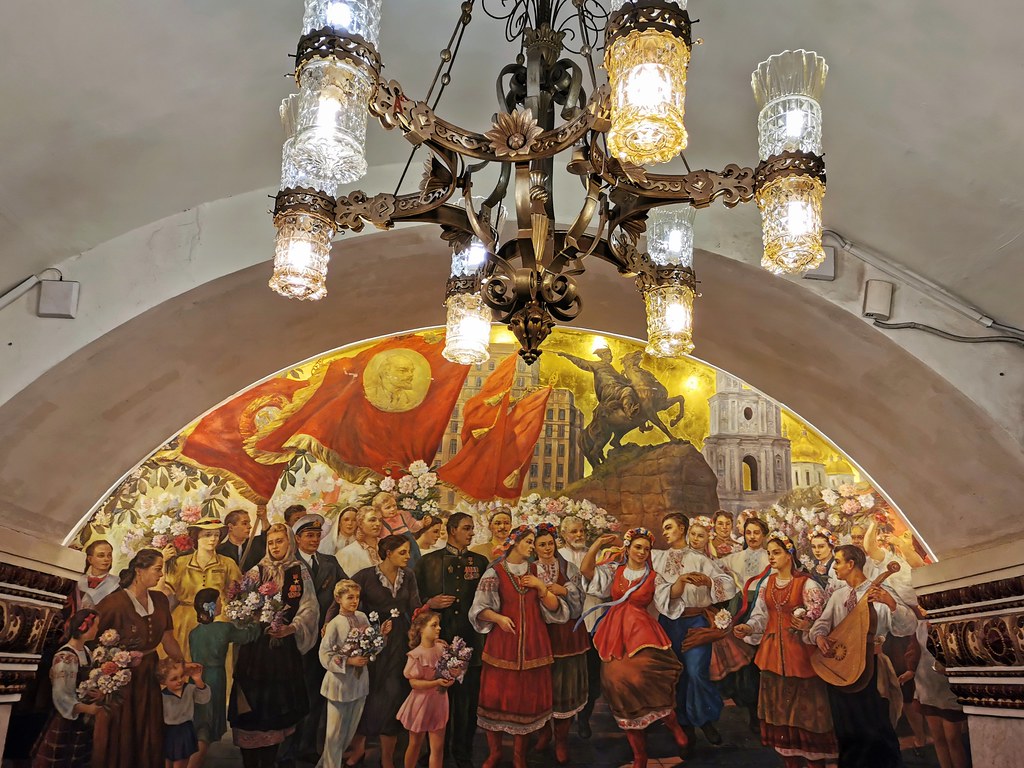
Change to the dark blue line and go west to:
6. Park Pobody. The columns are white and rust marble producing a very sleek, modern look. At the end is a large enamelled ceramic celebrating the end of WW II in 1945.


7. Arbatskaya. Along with Smolenskaya and Kievskaya, it was built in 1953 to replace an older, parallel section of track that has since become part of the Filyovskaya Line. The old station had been damaged in a German bomb attack in 1941, so its replacement was much deeper and included larger stations that could double as shelters. Although it was initially supposed to be closed permanently, the old section was reopened five years later.

Continue on the dark blue line to:
8. Ploshchad Revolyutsii. 76 life-size bronze statues of soldiers, farmers, children and workers are on the dark marble columns. It is good luck to rub the nose of the dog, the chicken and the little boy’s penis so the dark brown patina is rubbed down to the golden bronze.
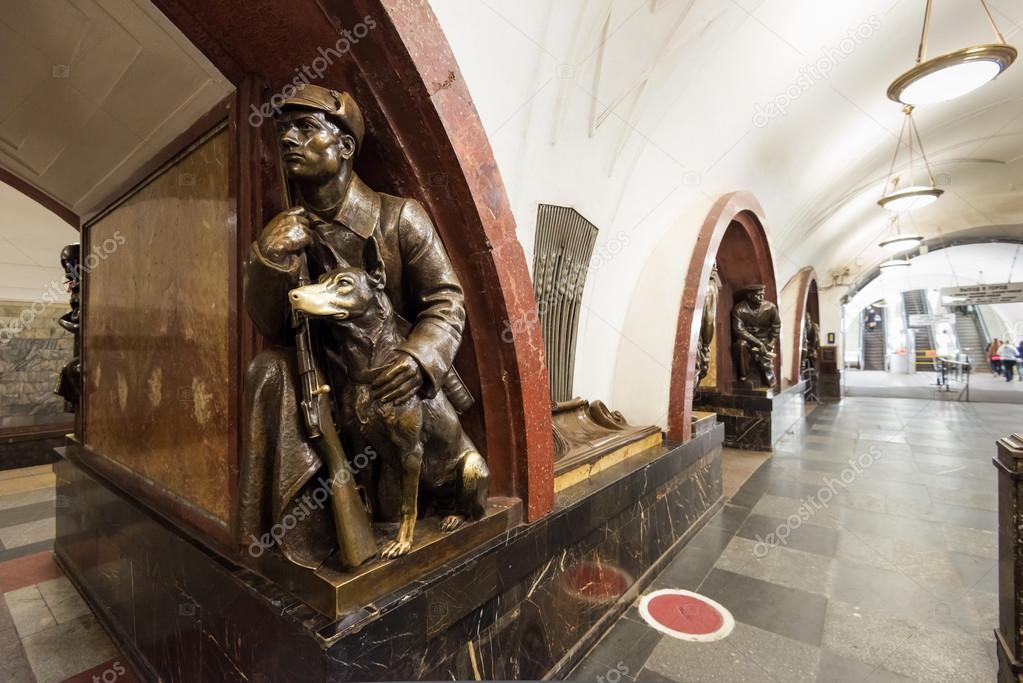
Bypass two stations staying on the dark blue line to:
9. Electrozavodskaya (Electric Factory). It is one of the more spectacular and better-known stations on the Moscow Metro opened in 1944. Aptly named for a nearby power plant, Elektrozavodskaya’s defining feature is the ceiling, which is almost completely covered by six rows of circular incandescent inset lamps – 318 in all.

In keeping with the electrical theme, the inside of the vestibule is decorated with portraits of pioneers in electricity and electrical engineering. The platform is relatively short, with only six white marble pylons on each side. The inward-facing sides of the pylons are decorated with bas-reliefs depicting the Soviet Union’s industrial and agricultural workers. The outside faces have sconces and decorative metal grilles depicting the hammer and sickle.
Return to the dark blue line changing to the brown line at Kurskaya and continue to:
10. Taganskaya. It was opened on January 1, 1950. The station is decorated with fourteen large triangular majolica panels including cameo portraits of Red Army heroes and intricate floral designs. The panels facing the centre are pale blue while those facing outwards are untinted. There was originally a marble bas-relief at the end of the platform depicting Stalin surrounded by an adoring throng but this was torn out in 1966 when the passage to Taganskaya-Radialnaya was built. Another artwork in the station is a circular ceiling panel entitled “Victory Salute” located in the intermediate hall between the two sets of escalators.

Return back on the brown line bypassing Kurskaya to:
11. Komsomolskaya. It opened on January 30, 1952. The station’s most noticeable feature is its grandiose Baroque-style ceiling painted pale yellow and encrusted with large mosaics and floral mouldings.
The ceiling is supported by 68 octagonal white marble columns with modified Ionic capitals. The artistic theme of the station is Russia’s fight for independence and historical struggles against invaders. In keeping with this theme are the eight large mosaics along the centre of the ceiling. At the end of the platform are a bust of Lenin and an arch decorated with gilt floral designs and the Soviet coat of arms. The station’s vestibule is a grand scale, with an immense octagonal dome, cupola, spire and an imposing full-height portico with stylized Corinthian columns. Most everyone will go through this station as it gives access to the trains to St Petersburg and the Trans-Siberian.

Continue on the brown line to Prospekt Mira and change to the orange line (Kaluzhsko-Rizhskaya line) to:
12. Prospekt Mira (Avenue of Peace). Opened on May 1, 1958, the station features flared pylons faced with white marble and trimmed with sharp-edged metal cornices. The walls are faced with off-white ceramic tile with horizontal black stripes.

Continue on the orange line heading south to Turgenevskaya where you change lines to the light green line at Stretensky Bulvar (stainless steel columns) heading north to:
13. Dostoevskaya. The light green line is a new line with this station opening in 2010. The marble murals are from scenes from Dostoyevsky’s books with a large portrait of the author at the end. One scene was controversial as it contained a murder scene.

Return on the light green line to:
14. Trubnaya. Another modern station has glass mosaics surrounded by metal light supports in the green marble columns.
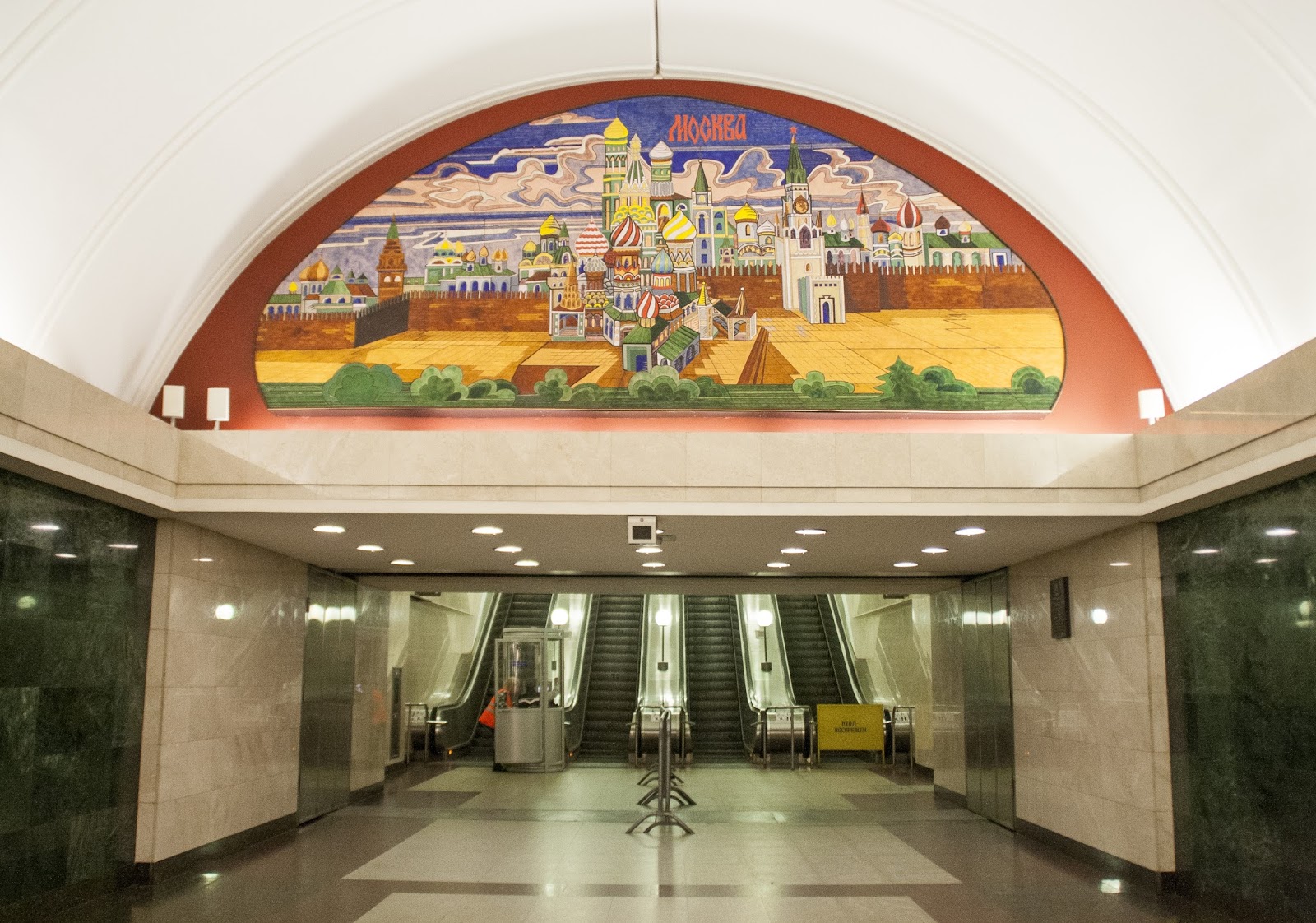
Trubnaya connects back to Tsvetnoy Bulvar and home! Have a good night’s sleep.
Other stations that were good but I did not see are Partiznaskaya (decorated with AK-47 machine guns), Novokunznetskaya (military bas-reliefs, ceiling mosaics and elegant marble benches), Shossi Entuziastov, and Nakhimovsky Prospekt.
